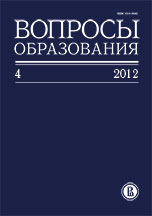Заочная форма обучения в учреждениях высшего профессионального образования: характеристики обучающихся (по данным статистики и Мониторинга экономики образования)
Аннотация
Материал подготовлен по данным статистики и Мониторинга экономики образования
Угольнова Людмила Евгеньевна — заместитель начальника отдела по работе с данными Института институциональных исследований НИУ ВШЭ. Эл. адрес: lugolnova@hse.ru
Характеристика ситуации в сфере заочного высшего образования в России представлена на основе статистических показателей, а также данных опросов обучающихся в учреждениях высшего профессионального образования и опросов работодателей, выполненных в рамках Мониторинга экономики образования.
Показано, что за последние десять лет количество студентов, обучающихся в вузах по заочной форме, выросло более чем вдвое и в настоящее время заочная форма обучения стала наиболее распространенной формой получения высшего профессионального образования. Приведены данные о распределении студентов между различными формами обучения в государственных и негосударственных вузах. Как в негосударственных вузах, так и в государственных (но в меньшей степени) наблюдаются тенденции к увеличению доли студентов заочной формы обучения и сокращению доли очной и вечерней форм обучения.
Представлены различия между студентами очной и заочной форм обучения в социально-демографических характеристиках, а также в образовательных и карьерных стратегиях. Определены причины, побудившие студентов выбрать заочную форму обучения. Представлена оценка студентов очных и заочных отделений вероятности работы в дальнейшем по той специальности, которую получают в вузе.
Опрос работодателей показал, что студенты очных отделений будут иметь некоторое преимущество при трудоустройстве после окончания обучения. Представлены сведения о предпочтениях работодателей при приеме на работу между выпускниками и кандидатами, продолжающими обучение в момент соискания должности.








